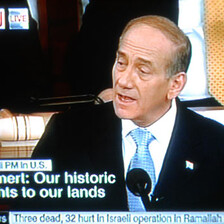The Electronic Intifada 2 June 2006

Samia Halaby’s drawing, “My Pal Palestine,” exhibits Palestinian resistance and protest to the apartheid wall and occupation. (Al-Awda NY)
What Israeli Prime Minister Ehud Olmert is attempting to pull off through unilateralism is historically unprecedented – to take a disputed territory and mark its own borders without taking in to account historical aspirations or negotiations. Convergence is a public relations term rather than something to be taken as seriously as diplomacy.
It will never be a sustainable course of action. It will more than likely perpetuate the vicious circle which has gone on since 1993 and could stoke the fires of a third intifada.
But then again, nothing about this conflict is about logic or reason or trying to find peace. It is about the distortions of systems and processes driven by the Israeli right wing, the needs of US foreign policy and to a degree by the lethargic acquiescence of the European Union. It is also about the management of fundamentalisms – an attempt to find order amongst disorder. As the prevailing theme in Israeli political life, the conflict has become normalized along a dangerous strain of thinking where the majority now support the ethnic transfer of Israeli Arabs.
The question of Labor leader Amir Peretz still remains open – is he prince or puppet? The darling of the Israeli Left is now Defense Minister in charge of authorizing targeted assassinations and home demolitions.
Former US President Jimmy Carter writing in USA Today about the plan said “It is inconceivable that any Palestinian, Arab leader, or any objective member of the international community could accept this illegal action as a permanent solution to the continuing altercation in the Middle East. This confiscation of land is to be carried out without resorting to peace talks with the Palestinians, and in direct contravention of the ‘road map for peace,’ which President Bush helped to initiate and has strongly supported.”
Olmert’s motivation in moving to convergence is to avoid a series of internal divisions. During the lead up to decision-making related to the disengagement from Gaza, Haaretz writer Aluf Benn recently reported that Olmert suppported the evacuation of 17 West Bank settlements. A disengagement of that size and larger could cost as much as 25 billion US dollars. It could start as soon as the summer of 2007 and could take up to two years to complete. Maintaining a coalition through this period would be difficult for Kadima. Even at the end of this process, the Palestinians would still not accept the final status borders. With a change in the US Administration in early 2009, there is no guarantee that the new leader will accept such a deviation from the Roadmap to Peace that both Ariel Sharon and Ehud Olmert have tried to fashion into a new reality. Bush has given Olmert the green light to move.
What will be building up over the next two years is an increasingly vocal call for economic sanctions against Israel largely led by churches and labour unions in North America and Europe. As Israeli public policy has willfully championed the use of time to solidify new realities on the ground such as the expansion of West Bank settlements and the construction of the Separation Wall, Israel will be held to a new standard as their cyclical strategy of denouncing the Palestinian leadership will be increasingly called into question.
The next four years seem to be about passing time rather than making peace. Israel has to get back to the negotiating table or the gig is up.
Ironically, Kosovo and Montenegro in the former Yugoslavia are closer to achieving independence than the Palestinians are.
Am Johal is a freelance writer from Vancouver, Canada who worked during 2004 in international advocacy with the Mossawa Center, the Advocacy Center for Arab Citizens of Israel.
Related Links





